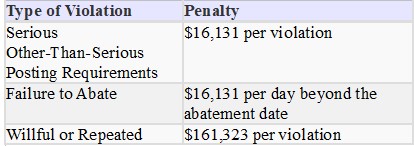
Excavation & Trenching Safety Program
Purpose
This program outlines procedures and guidelines for the protection of employees working in and around excavations and trenches. This program requires compliance with OSHA Standards described in Subpart P (CFR 1926.650) for the construction industry.
Compliance is mandatory to ensure employee protection when working in or around excavations. The programs in this manual on confined space, hazard communication, lock-out/tag-out, respiratory protection, and any other safety programs or procedures deemed essential for employee protection, are to be used in conjunction with this program.
SCOPE
This program pertains to all company projects that require any excavations or trenches.
REFERENCES
• 29 CFR 1926.650, Subpart P - Excavations
• Excavation Equipment Manufacturer Safety Procedures
RESPONSIBILITIES
It is the responsibility of each superintendent and supervisor to implement and maintain the procedures and steps set forth in this program. Each employee involved with excavation and trenching work is responsible to comply with all applicable safety procedures and requirements of this program.
DEFINITIONS
BENCHING - A method of protecting employees from cave-ins by excavating the sides of an excavation to form one or a series of horizontal levels or steps, usually with vertical or near vertical surfaces between levels.
CAVE-IN - The separation of a mass of soil or rock material from the side of an excavation, or the loss of soil from under a trench shield or support system, and its sudden movement into the excavation, either by failing or sliding, in sufficient quantity so that it could entrap, bury, or otherwise injure and immobilize a person.
COMPETENT PERSON - One who is capable of identifying existing and predictable hazards in the surroundings or working conditions, which are unsanitary, hazardous, or dangerous to employees, and who has authorization to take prompt corrective measures to eliminate them.
DURATION OF EXPOSURE - The longer an excavation is open, the longer the other factors have to work on causing it to collapse.
EXCAVATION - Any man-made cut, trench, or depression in an earth surface, formed by earth removal.
HAZARDOUS ATMOSPHERE - An atmosphere which by reason of being explosive, flammable, poisonous, corrosive, oxidizing, irritating, oxygen deficient, toxic, or otherwise harmful, may cause death, illness, or injury.
PROTECTIVE SYSTEM - A method of protecting employees from cave-ins, from material that could fall or roll from an excavation, or from the collapse of adjacent structures. Protective systems include support systems, sloping and benching systems, shield systems, and other systems that provide necessary protection.
SHIELD - A structure that is capable of withstanding the forces imposed on it by a cave-in and thereby protects employees within the structure. Shields can be permanent structures or can be designed to be portable and moved along as work progresses. All shields must be in accordance with 29 CFR 1926.652(c)3 or (c)4.
SLOPING - A method of protecting workers from cave-ins by excavating to form sides of an excavation that are inclined away from the excavation to prevent cave-ins. The angle of incline required to prevent a cave-in varies with differences such as soil type, length of exposure, and application of surcharge loads.
SURCHARGE LOADS - Generated by the weight of anything in proximity to the excavation, push starts for a cave-in (anything up top pushing down). Common surcharge loads:
• weight of spoil pile
• weight of nearby buildings, poles, pavement, or other structural objects.
• weight of material and equipment
TRENCH - A narrow excavation below the surface of the ground, less than 15 feet wide, with a depth no greater than the width.
UNDERMINING - Undermining can be caused by such things as leaking, leaching, caving or over-digging. Undermined walls can be very dangerous.
VIBRATION - A force that is present on construction sites and must be considered. The vibrations caused by backhoes, dump trucks, compactors and traffic on job sites can be substantial.
Hazards
One of the reasons the company requires a competent person on-site during excavation & trenching are the numerous potential hazardous that may be encountered or created. Hazards include:
Electrocution
Gas Explosion
Entrapment
Struck by equipment
Suffocation
Hazard Controls
Before any work is performed and before any employees enter the excavation, a number of items must be checked and insured:
• Before any excavation, underground installations must be determined. This can be accomplished by either contacting the local utility companies or the local "one-call' center for the area. All underground utility locations must be documented on the proper forms. All overhead hazards (surface encumbrances) that create a hazard to employees must be removed or supported to eliminate the hazard.
• If the excavation is to be over 20 feet deep, it must be designed by a registered professional engineer who is registered in the state where work will be performed.
• Adequate protective systems will be utilized to protect employees. This can be accomplished through sloping, shoring, or shielding.
• The worksite must be analyzed in order to design adequate protection systems and prevent cave-ins. There must also be an excavation safety plan developed to protect employees.
• Workers must be supplied with and wear any personal protective equipment deemed necessary to assure their protection.
• All spoil piles will be stored a minimum of four (4) feet from the sides of the excavation. The spoil pile must not block the safe means of egress.
• If a trench or excavation is 4 feet or deeper, stairways, ramps, or ladders will be used as a safe means of access and egress. For trenches, the employee must not have to travel any more than 25 feet of lateral travel to reach the stairway, ramp, or ladder.
• No employee will work in an excavation where water is accumulating unless adequate measures are used to protect the employees.
• A competent person will inspect all excavations and trenches daily, prior to employee exposure or entry, and after any rainfall, soil change, or any other time needed during the shift. The competent person must take prompt measures to eliminate any and all hazards.
• Excavations and trenches 4 feet or deeper that have the potential for toxic substances or hazardous atmospheres will be tested at least daily. If the atmosphere is inadequate, protective systems will be utilized.
• If work is in or around traffic, employees must be supplied with and wear orange reflective vests. Signs and barricades must be utilized to ensure the safety of employees, vehicular traffic, and pedestrians.
COMPETENT PERSON RESPONSIBILITIES
The OSHA Standards require that the competent person must be capable of identifying existing and predictable hazards in the surroundings, or working conditions which are unsanitary, hazardous, or dangerous to employees, and have authorization to take prompt corrective measures to eliminate them and, if necessary, to stop the work.
A competent person is required to:
• Have a complete understanding of the applicable safety standards and any other data provided.
• Assure the proper locations of underground installations or utilities, and that the proper utility companies have been contacted.
• Conduct soil classification tests and reclassify soil after any condition changes.
• Determine adequate protective systems (sloping, shoring, or shielding systems) for employee protection.
• Conduct all air monitoring for potential hazardous atmospheres.
• Conduct daily and periodic inspections of excavations and trenches.
• Approve design of structural ramps, if used.n.
EXCAVATION SAFETY PLAN
An excavation safety plan is required in written form. This plan is to be developed to the level necessary to insure complete compliance with the OSHA Excavation Safety Standard and state and local safety standards.Excavation safety plan factors:
• Utilization of the local one-call system• Determination of locations of all underground utilities
• Consideration of confined space atmosphere potential
• Proper soil protection systems and personal protective equipment and clothing
• Determination of soil composition and classification
• Determination of surface and subsurface water
• Depth of excavation and length of time it will remain open
• Proper adherence to all OSHA Standards, this excavation and trenching safety program, and any other coinciding safety programs.
SOIL CLASSIFICATION AND IDENTIFICATION
The OSHA Standards define soil classifications within the Simplified Soil Classification Systems, which consist of four categories: Stable rock, Type A, Type B, and Type C. Stability is greatest in stable rock and decreases through Type A and B to Type C, which is the least stable. Appendix A of the Standard provides soil mechanics terms and types of field.

GET INSTANT ACCESS
to THE MEMBERS LIBRARY
Safety materials created by safety professionals.
Access to the Safety Manager software.
Wide variety of safety videos and courses.
**Brand New** Safety Training Management System
Pre-Made Safety Materials Ready For Use
Created by experienced safety professionals & risk consultants. Saving you time, money, and risk of injuries.
95% of the work already done.
Below are the maximum penalty amounts, with the annual adjustment for inflation, that may be assessed after Jan. 15, 2024. (See OSHA Memo, Jan. 8, 2024).

**New OSHA HEAT 90 DAY**
>>Download Free HERE<<
**New 2024 OSHA 300 Form**
>>Download Free HERE<<
**Brand New**
Free with full membership subscription
Training LMS System
Ask The Safety Consultant
Safety Equipment Deal Finder

“SafetyInfo.com is the first go-to website for safety professionals and companies to use in establishing a solid safety program"
-Mike McKenzie, Certified Safety & Health Manager (CSHM), McSafety Solutions™
Note: You must have a full subscription to the Safety Library in order to use this material. Any use outside of your organization, for resell, or without an active membership is strictly prohibited and may result in prosecution under copyright infringement laws. Please contact us first, if you would be interested in reselling or using our materials for reproduction.
Inside the Members Library
Topic Index
Accident Prevention
Air Quality
Asbestos
Bloodborne Pathogens
Boilers
Chemical Safety
Compressed Gas
Confined Space
Construction
Construction Worksite
Cranes & Slings
Driver / Fleet Safety
Drug Free Workplace
Electrical
Emergency Management
Engineering Safety
Environmental
Equipment
Ergonomics
Fall Protection
Fire Safety & Prevention
First Aid
Flammable Materials
Forklifts
Hazard Communication
Hazardous Materials
Hearing Protection
Heat Stress
Hot Work
Housekeeping
Job Safety Analysis
Laboratory
Ladders
Lead
Lockout-Tagout
Machinery & Equipment
Material Handling
MSDS (SDS)
Medical & First Aid
Occupational Health
Office Safety
Off the Job Safety
Personal Protection
Process Safety
Record Keeping
Respiratory Protection
Silica Safety
Rules & Policies
Signs & Labels
Slips, Trips & Fall
Training
Terrorism Programs
Tool Safety
Vehicle & Driver
Violence Programs
Welding & Hot Work
Training Videos
Library Index
Training Materials
Videos/Courses
Talks
Articles
PowerPoint
Handouts
Training Overheads
Quizzes
Supervisor Briefs
Management Briefs
Safety Sessions
2 Minute OSHA Safety Talks
Pamphlets
First Aid Training
Supervisor Training
Hazardous Materials
Bomb Threat
Crossword Puzzles
Biological Agents
Forms & Documents
Forms
Checklists
Audit Guides
Inspections Guides
Signs & Labels
Environmental Audit Guides
Recordkeeping - OSHA 300
Sign & Label Maker
Safety Management Resources
Safety Manuals/Written Programs
Ergonomic Programs
Emergency Plans
Process Safety Management
Construction Safety
Occupational Health
Environmental
Topic Sheets
DOT Fleet-Driver
Hazardous Materials
Chemical Safety
Drug Free Workplace
Terrorism Programs
Development Guides
Safety Manager Software
Safety References & Graphics
Technical Safety Information
Posters
Topic & Fact Sheets
Development Information
Job Specific Safety Rules
Terrorism
Calculators
Safety Comic Strips
New Safety Training System
Schedule and train your employees with our materials. Add unlimited amount of employees. Record all progress and issue certificates. For group and individual training sessions.

